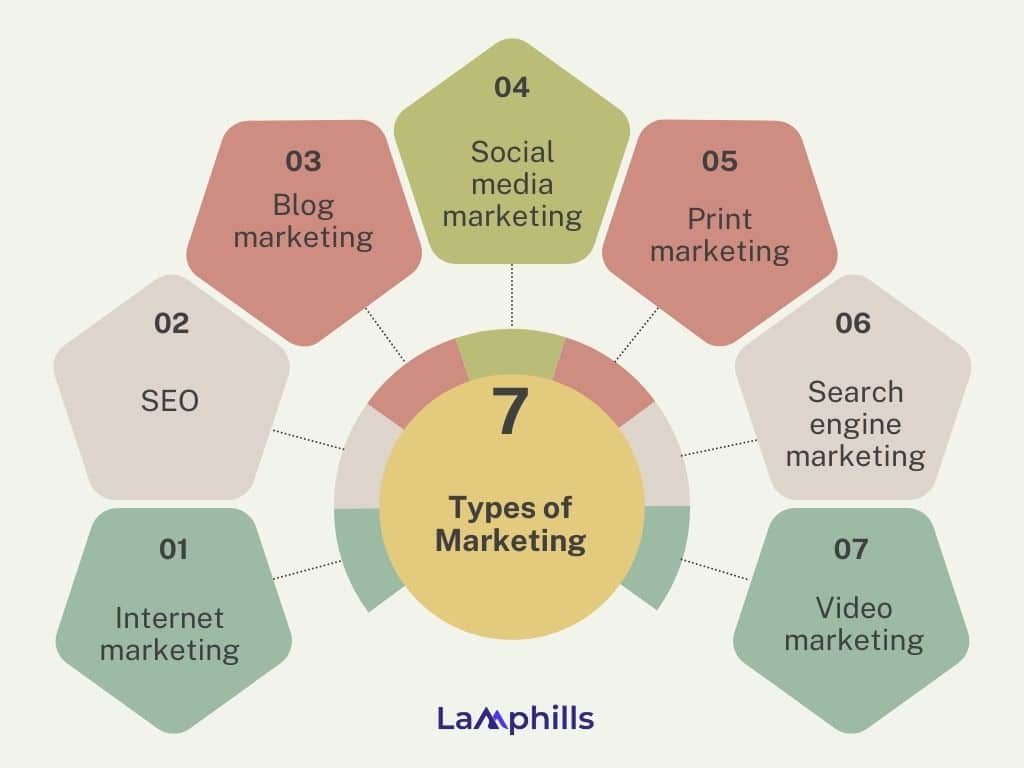When it comes to advertising vs. marketing, there are several key differences. Yes, they might seem similar and serve most of the same functions; however, their point of application happens to be the major difference.
Marketing and advertising both seek to optimize customer communication, provide consumers with relevant content, and ultimately generate more sales, but they employ different methods to meet their shared objectives. It’s important to understand these differences so you can gain a better understanding of the specific strategies for each function.
Key Points
- Advertising is a component of a company’s marketing strategy. Companies can use various advertisements to reach their target consumers or to inform the public.
- Types of advertising include social media advertising, PPC, mobile advertising and direct mail, among others.
- Major types of advertising strategies include content advertising, pull advertising and push advertising.
- Marketing refers to any actions a company takes to attract an audience to the company’s product or services through high-quality messaging.
- The marketing mix is a decision-making matrix for making marketing decisions in any business. It is divided into four Ps: Product, Pricing, Place and Promotion.
- Types of marketing include SEO, SEM, internet marketing, and blog marketing, among others.
- A marketing strategy determines how to reach prospective consumers and turn them into customers. It contains the company’s value proposition, key brand messaging, data on target customer demographics, and other high-level elements.
- Key differences between advertising vs. marketing include responsibility, purpose, techniques used, investment required, success measurement and generating results.
Advertising vs. Marketing: What Is Advertising?
Companies use advertising to share information about their products or services through various media. The advertising landscape has changed with technology, with print and broadcast advertising serving as the traditional format and digital advertising serving as a more modern option.
With technology, companies gain new ways of targeting consumers and tracking the effectiveness of their advertising campaigns.
Advertising vs. Marketing: Types Of Advertising
Companies can use various advertisements to reach their target consumers or to inform the public. Here are the most common types of advertising and examples:

Social media advertising is a popular choice for small businesses because the cost is relatively affordable and you can be highly selective with the audience you target. For example, if you own a retail store, you can use ad targeting options to narrow the audience so that only people of a certain demographic living within a certain mile radius of your store are served your social ads.
#2. Pay-Per-Click Advertising
Pay-per-click (PPC) advertising is a type of online advertising where advertisers pay a fee every time a user clicks on one of their ads, usually through a search engine. Advertisers bid on ad placements within the search engine, meaning they set a maximum price they’re willing to pay for a user to click on their ads. If a person sees your ad but doesn’t click on it, you aren’t charged anything.
The most common platforms for PPC advertising are Google Ads and Bing Ads. PPC advertising is a form of search engine marketing (SEM). It can be a great option for small businesses with limited budgets and according to WordStream, businesses make $2 in revenue on average for every $1 they spend on Google Ads.
#3. Mobile Advertising
Mobile advertising is a type of digital advertising in which ads are served only on mobile devices, including smartphones and tablets. It can include:
- Mobile display ads
- Mobile search ads
- Mobile videos
- Mobile app ads, which are meant to drive downloads of a brand’s app
- Social media ads served on mobile devices only
Having a mobile advertising strategy can pay off for your small business. Eighty-four percent of adult customers under the age of 30 are most likely to shop online using a mobile device.
#4. Print Advertising
Print advertising used to be the primary advertising method for small businesses before the advent of digital advertising. Now, print ad revenues are shrinking and as a small business owner, you may find the cost is much higher than the cost of digital and social advertising. It’s also more difficult to measure the success of your print advertising campaigns since it’s almost impossible to prove how many people who saw your ads in print went on to make a purchase at your store or become a client of your business.
However, for some local businesses or businesses that target older, less digitally engaged audiences, print advertising can still be a good choice for your ad spend. Print advertising includes newspaper ads, magazine ads, and ads in brochures and flyers.
#5. Broadcast Advertising
Broadcast advertising includes mass-market media like TV and radio. While broadcast advertising, especially TV ads, can be cost-prohibitive for small businesses, if you have local TV and radio stations near you, the cost might be more affordable and the audience could be highly relevant to your local business.
The cost of broadcast ads depends on several factors, including the length of the ads (longer TV and radio ads will cost more to air), the frequency they play, and the time of day they’re aired. You’ll also need to factor in the cost of producing the ads since professional TV ads can be quite expensive to produce.
#6. Out-Of-Home Advertising
Out-of-home or outdoor advertising refers to any advertising that reaches people when they’re outside of their homes. This includes billboard ads, digital signage, transit ads (i.e. bus shelters, train ads, subway stop ads, etc.), street furniture ads, and ads in sports venues. Out-of-home advertising can be quite expensive, so be sure it fits with your advertising budget.
#7. Direct Mail Advertising
Direct mail advertising involves all forms of ads that are delivered to a person’s home through the mail. This includes brochures, catalogs, sales letters, and newsletters.
While direct mail is a less popular advertising method for small businesses than digital advertising, it can be successful if you develop a creative, visually appealing direct mail campaign. Direct mail ads enable you to deliver your message one-on-one to local consumers.
Advertising vs. Marketing: Advertising Strategies
There are many possible advertising strategies, as each brand’s situation, identity, and objectives are unique. To get an idea of the possibilities, let’s take a look at the 3 major types of advertising strategies.
#1. Content Advertising
This advertising strategy seeks to directly influence consumers through different channels with a direct, clear message that aims to reach as many people as possible. Although it is similar to content marketing, it is not the same since it is more direct and more focused on the brand.
Within content advertising, we can distinguish the following different subtypes:
- Informative advertising: this focuses on showing the brand and the value it can bring to potential customers. It is usually based on rational values.
- Comparative advertising: this focuses on comparing a brand with the competition to reinforce the characteristics that differentiate it and convince the consumer that it can provide greater benefits. Although this can be very effective, you must be very careful when making your claims in order not to run into legal problems.
- Emotional advertising: if informative advertising is based more on rational factors, emotional advertising seeks to get an emotional reaction. It can be very effective in influencing purchasing decisions since we know that these have a strong subconscious component that is based on how people feel about a product or service.
#2. Pull Advertising
This advertising strategy is typical of brands that are already well-known and well-positioned in the market. Instead of going after customers, this strategy aims to keep a brand in the consumer’s mind and propel people towards it. It focuses on identification with the brand and long-term loyalty.
#3. Push Advertising
This advertising strategy is more suitable for new products or services since it seeks to make something known among consumers to position well and generate sales.
The push strategy can use different channels, from traditional media to social ads. In many cases, it goes hand in hand with pricing strategies. For example, offering cheaper launch prices to generate an initial critical mass of consumers.
It is also common for push advertising to be done in tandem with content marketing so that a new brand can establish its authority early on and position itself as an expert in its sector.
Here are some of the most widely used and effective advertising strategies, according to PPCExpo and other experts in marketing and advertising.
Advertising Strategies
Advertising vs. Marketing: What Is Marketing?
Marketing refers to any actions a company takes to attract an audience to the company’s product or services through high-quality messaging. Marketing aims to deliver standalone value for prospects and consumers through content, with the long-term goal of demonstrating product value, strengthening brand loyalty, and ultimately increasing sales.
The purpose of marketing is to research and analyze your consumers all the time, conduct focus groups, send out surveys, study online shopping habits, and ask one underlying question: “Where, when, and how does our consumer want to communicate with our business?”
The Marketing Mix
The “marketing mix” was first coined by Neil Borden, a world-renowned Harvard professor in marketing and advertising. According to Borden, the marketing mix is a decision-making matrix for making marketing decisions in any business.
At first, the marketing mix was divided into the 4Ps:
- Product: The service or the product that your business offers that addresses the specific needs and desires of your ideal customers.
- Price: How much money customers will pay your business to receive your product or service. Price also helps dictate how profitable your business will be.
- Place: Where and how your customers can find and access your products and services, including retail or resellers, distribution, franchising, and others.
- Promotion: How your business communicates the benefits and uses of your product or service. This is where advertising comes in.
Through the years, however, the 4Ps have expanded to the 7Ps, including more parameters that are particularly relevant for those businesses that provide services and not just products:
- People: Who provides the service of your business. Every business needs to rely on qualified, competent people to deliver services to their customers.
- Process: The standard operating procedure that your people follow to show customers exactly what they receive when they purchase your service.
- Physical evidence: What tangible benefit do your customers receive as part of your service? For instance, if you are an advertising agency, the physical evidence might be the results your campaigns provide to your clients’ sales numbers.
Advertising vs. Marketing: Types of Marketing
Where your marketing campaigns live depends entirely on where your customers spend their time. It’s up to you to conduct market research that determines which types of marketing — and which mix of tools within each type — is best for building your brand.
Here are several types of marketing that are relevant today, some of which have stood the test of time:

#1. Internet Marketing
Inspired by an Excedrin product campaign that took place online, the very idea of having a presence on the internet for business reasons is a type of marketing in and of itself.
#2. Search Engine Optimization
Abbreviated “SEO,” this is the process of optimizing content on a website so that it appears in search engine results. It’s used by marketers to attract people who perform searches that imply they’re interested in learning about a particular industry.
#3. Blog Marketing
Blogs are no longer exclusive to the individual writer. Brands now publish blogs to write about their industry and nurture the interest of potential customers who browse the internet for information.
#4. Social Media Marketing
Businesses can use Facebook, Instagram, Twitter, LinkedIn, and similar social networks to create impressions on their audience over time.
#5. Print Marketing
As newspapers and magazines get better at understanding who subscribes to their print material, businesses continue to sponsor articles, photography, and similar content in the publications their customers are reading.
#6. Search Engine Marketing
This type of marketing is a bit different than SEO, which is described above. Businesses can now pay a search engine to place links on pages of its index that get high exposure to their audience. (It’s a concept called “pay-per-click” — I’ll show you an example of this in the next section).
#6. Video Marketing
While there were once just commercials, marketers now put money into creating and publishing all kinds of videos that entertain and educate their core customers.
Marketing Strategies
A marketing strategy refers to a business’s overall game plan to facilitate the buying and selling of its products or services. A marketing strategy determines how to reach prospective consumers and turn them into customers. It contains the company’s value proposition, key brand messaging, data on target customer demographics, and other high-level elements.
A thorough marketing strategy covers the four Ps of marketing: product, price, place, and promotion.
How To Create A Marketing Strategy
Advertising vs. Marketing: Key Differences
Now that we understand what exactly advertising and marketing are and how they relate to one another, let’s explore the key differences between them.
Responsibilities
Advertising
Let’s take a look at what advertising responsibilities include:
- Customer analysis. Getting to know your existing customers and their relationship with your business can help your team create better ad campaigns moving forward and develop advertising strategies that can serve the brand as managed by your marketing team.
- Pitching advertising strategies and plans. Whether you’re working with clients for their advertising needs or if you’re working with agencies yourself, the advertising team is responsible for pitching the strategy to market the business, including specific activations, processes, and budgets required to enact an advertising strategy.
- Media buying. Advertising teams stay on top of the most effective marketing channels for the business based on sound data, including where customers for the business can be reached at the best value.
- Creative production. From TV commercials to short social media posts, advertising teams are responsible for planning, researching, creating, and distributing creative assets that align with the advertising plan. These include ad copy, images, videos, and audio elements.
- Campaign management. Advertising teams are responsible for tracking and monitoring the performance of ad campaigns, and optimizing copy and images as needed to get the highest ROAS (return on ad spend).
- Communication between stakeholders. Accounts managers of advertising agencies are responsible for keeping clients informed about progress while also maintaining their agency’s own creative team’s project slate.
Marketing
Since marketing aims to boost a business’s visibility and desirability to potential and existing customers, it has the following responsibilities:
- Branding. Your brand is who you are in the market; it is a culmination of how you act, communicate, and invite prospects into your business that makes you different from other companies in the same space. Your brand is what will last in the minds of consumers.
- Trend analysis and competitor tracking. Marketing teams have to know where your brand sits compared to your current competition, and this also includes getting to know trends in the market. They’ll be watching out for their competitors’ campaigns, trending topics in their industry, and what customers are saying about them and their competition.
- Cross-department alignment. Your marketing team is not the only team in a business. Because many departments work together to keep a business running smoothly, your marketing team must ensure that all departments understand and support your marketing activities, brand, and goals.
- Customer relationship management. Marketing teams can use surveys and interviews among other feedback collection tools and activities to determine if the business meets their customers’ expectations.
- Market research and strategy development. An ongoing responsibility of marketing teams is making sure the business is positioned for profitability. They have to see what’s hot in the market, stay on top of effective marketing tools and strategies, and manage new software and programs that might help the business run smoother in support of its other roles, like customer management and after-sales support.
- Budgeting and ROI (return on investment) tracking. A marketing team makes sure that they’re not overspending. Based on year-after-year data, the team plans out their marketing budget and makes sure all marketing activities fall within their budget. They do all this with awareness of their desired ROI to make sure that the investment in marketing is worthwhile.
Purpose
While marketing and advertising share the ultimate goal of boosting sales and profitability, they tend to deviate in the ways they accomplish this. Here is a breakdown of the purpose and goals of marketing vs advertising:
Advertising
- Building brand awareness
- Boosting brand recognition
- Attracting first-time buyers to purchase
- Informing or reminding customers about the existence of your brand
- Compelling customers to purchase through ads
- Increasing brand loyalty
- Keeping the brand’s image strong
- Establishing the business as the top-of-mind option among others in the market
- Motivating existing customers to make repeat purchases
Marketing
- Lead generation
- New customer acquisition
- Customer retention
- Maintaining consistent branding
- Managing and creating upsell and cross-sell opportunities
- Product development
- Tracking the results of all marketing initiatives as a whole
Techniques used
Because marketing and advertising have different goals, it comes as no surprise that they use different techniques to meet said goals.
Advertising
- Traditional advertising, e.g. print, TV, or radio
- Retail advertising, e.g. shelf marketing and in-store promotional material.
- Digital advertising, e.g. social media ads, video marketing, content syndication, guest posting, etc.
- Native advertising and promoting ads that match the look and feel of the webpage where they appear. This makes the ad less intrusive to the viewer, so they are more likely to engage with it.
- Billboard ads
- Mobile ads in apps
Marketing
- Inbound marketing. Using organic strategies to attract your customers to your business. Here’s an example of an inbound marketing blog post on the Outbrain blog – it educates affiliate marketers about the best affiliate programs and draws them to Outbrain’s site at the same time.
- Content marketing. Content marketing uses all types of content – landing pages, blogs, social posts, YouTube videos, and more – to attract audiences online and generate interest in a business or brand.
- Email marketing. Your business can stay in touch with customers through email campaigns, newsletters, and promotions.
- Search engine optimization. By getting your business ranked higher on Google, you gain visibility and draw traffic to your website.
- Affiliate marketing. By partnering with the right affiliates who can reach more customers, you can leverage other trusted people to market your brand for you in exchange for a commission.
Investment Required
Besides organic social advertising, most advertising formats require a budget, making advertising one of the costlier marketing activities your company will invest in. This cost can also depend on who you work with to implement your advertising plans, including any freelancers and contractors as well as agencies who create, plan, and report on their campaigns with you.
If you plan to advertise using internal talent, you might find that you’ll need to build a team that includes media buyers, copywriters, video editors, and the like.
And finally, a key investment in advertising is of course your actual ad spend. Each advertising platform, from TV to native to social media, has its own cost to put your ads on their platform.
Since marketing activities include other things like branding and customer and trend research, marketing costs as a whole may cover different positions and tools that are required to support these marketing goals. Examples include hiring product managers, brand managers, sales managers, or research analysts who can make sure that each marketing activity for your business is taken care of.
If your business is planning a rebrand in the future, then a big chunk of your marketing budget may have to go to the research and development for the rebranding, together with subsequent expenses to make sure the market is aware of your rebranding efforts.
And finally, marketing investments can also include the different software and tools you need to support other marketing activities. This might include email marketing providers, marketing automation platforms, or research companies to conduct detailed customer research and reporting.
Success Measurements
In both marketing and advertising, your business needs to stay on top of performance and make sure your tactics are successful. By optimizing and consolidating successful campaigns, and discarding tactics that are not working among your target audience, you can maintain the efficiency of your marketing and advertising investments and ensure the business is as profitable as possible.
Here are examples of different success metrics for both marketing and advertising that should be tracked, monitored, and optimized:
Advertising
- Return on Ad Spend (ROAS)
- Reach and Impressions
- Click-through Rates (CTR)
- Engagement
- Conversion Rates
Marketing
- Net Promoter Score
- Customer Retention
- Customer Lifetime Value
- Quarterly and Annual Sales Revenue
- Market Share
Generating Results
Finally, let’s look at how long it takes for each to generate results for your business. Remember that advertising is a part of marketing, so it should make sense that advertising is meant to have faster results and returns for your brand, while marketing activities are meant to be more long-term and build up your brand for the future.
For advertising campaigns, you need to consider the campaign duration to monitor results. For example, if you run a month-long campaign, then you’ll want to see the results generated after said month. You can also recheck a couple of months after to see if it has had a longer-term impact.
Meanwhile, with marketing, you’ll want to look at this as a lifelong process. Your business and brand will evolve as will your customers and market trends. However, it is critical to monitor the effects of marketing campaigns in the shorter term, so you can understand the status of your brand health, what resonates with audiences, and where to go from here.
Advertising vs. Marketing: Importance Of Advertising
Advertising is an important part of trade and commerce for multiple reasons, including:
Increases Sales
Advertising’s main goal is to increase the number of people who buy your product. You can achieve this by using advertisements to persuade customers that your product is high-quality, useful or desirable. An effective advertisement can convince customers to purchase your product, which may dramatically improve your overall sales.
Informs Customers
Creating an advertisement is a simple way to inform potential customers of your product and any advantages or features it may have. You can include important information such as the function of a product, where you can buy it, price, and unique qualities in a short period. Advertising also allows you to tell your audience about promotions such as sales, special services for new customers, or special events.
When your company introduces a new product or service, you can create an ad to inform your customers about it. This allows you to show the new product to a large number of people and create an interest in the release. Telling a larger amount of people about your product release may increase the number of people who want to buy it.
Retains Customers
Using advertising can help remind your customers about your brand and may encourage them to continue buying your product. A customer who once used your product may see an advertisement and remember their positive experience. This can motivate them to purchase that product again or try other services from your company.
Differentiates Your Brand & Increases Customer Trust
Because most products and services have multiple companies competing for customers, your company may need to find ways to distinguish itself from competitors. Advertising elements such as logos, color schemes, fonts and taglines are ways to establish a brand identity and create a difference between your product and other companies. If a customer recognizes or likes your brand design, that may increase the chances of them purchasing your product.
This can increase familiarity and trust between you and your customers. If a potential customer sees multiple ads about your product, they may consider you a trusted brand. You can also use advertising to address any concerns, which further builds trust between your company and your customers.
Reaches Target Customers
Using advertising can help you easily identify or market toward a particular target audience. After researching a target audience, you can release an ad that may appeal to them at locations they usually frequent. If you have more than one target audience, you can create separate ads and market to both audiences in different areas.
Explains Company Values
A company with powerful, visible values can resonate with customers and may encourage brand loyalty. Advertisement allows you to describe your company’s core traits or values to a wide audience and may encourage them to try your product. Having clear company values can also increase customer trust and may strengthen a brand’s identity.
Advertising vs. Marketing: Importance of Marketing
A completed marketing strategy typically includes brand objectives, target audience personas, marketing channels, key performance indicators, and more.
A marketing strategy will:
- Align your team to specific goals.
- Help you tie your efforts to business objectives.
- Allow you to identify and test what resonates with your target audience.
- Empower you to capitalize on emerging trends.
The last one is especially important. Keeping up with marketing trends is important for your strategy, but it could be a full-time job. Why? Because almost 80% of marketers say this industry changed more in the last three years than it has in the past five decades.
Add to that the fact that 50% of marketers believe their marketing strategy in 2023 was only *somewhat effective,* which means there’s plenty of room for improvement.
Advertising vs. Marketing: Conclusion
The main difference between advertising vs. marketing is their application.
The objective of both marketing and advertising is to inform consumers about products and services with the shared aim of driving consumers to make a purchase. It’s a common mistake to use the terms marketing and advertising interchangeably, but they’re not synonyms. Advertising is just one element of the wider marketing function.
Marketing is a broad area that entails strategy development, product development, consumer insights and understanding, data analysis, design, brand, and both qualitative and quantitative market research. It aims to gain an understanding of the marketing environment, develop and define products or services and prepare them for the market.
Advertising, on the other hand, is focused on how marketers communicate information about the product or service to their consumers.
Recommended Articles
- 9 Personal Branding Hacks for Insane Growth in 2024
- PR for B2B Companies: Tailoring Your Approach to Reach Decision-Makers
- PR BUSINESS: Shaping Perceptions and Building Brands Through Public Relations (The People’s Voice)
- 10 Most Resounding Influencer Marketing Fails in History (Lessons to Learn)
- CONTENT MARKETING: A User-Guide to Developing Your Business
- How to Monitor Competitors in 10 Effective Steps






